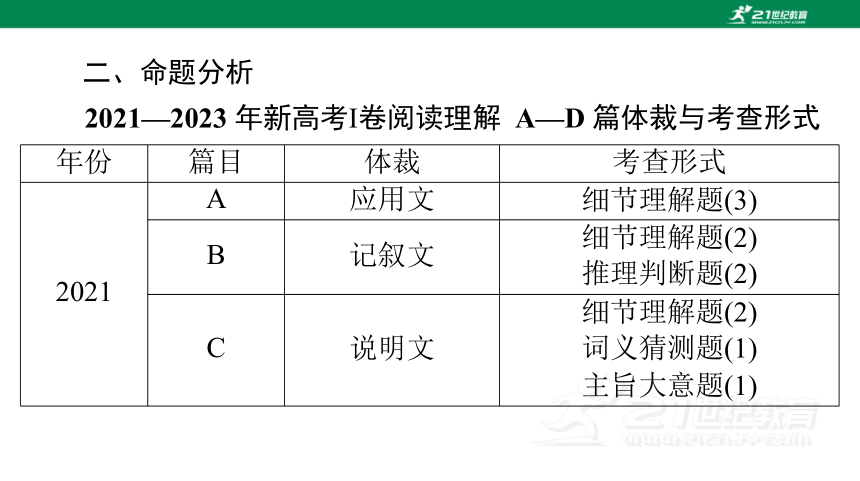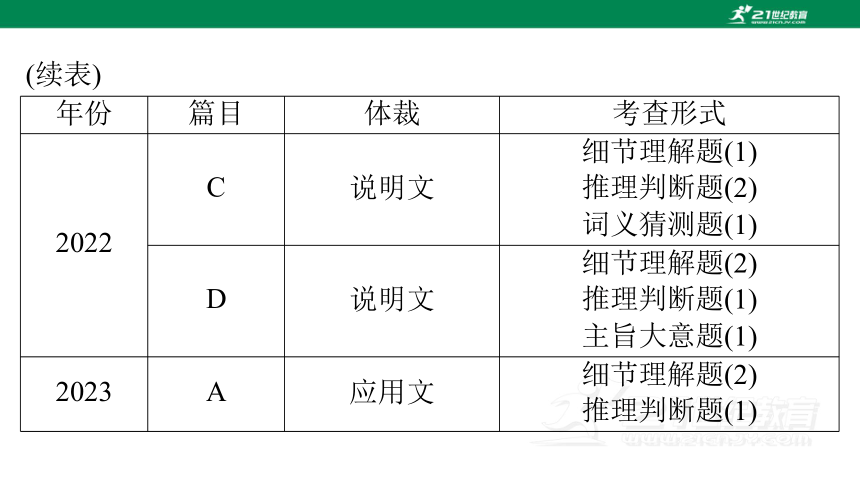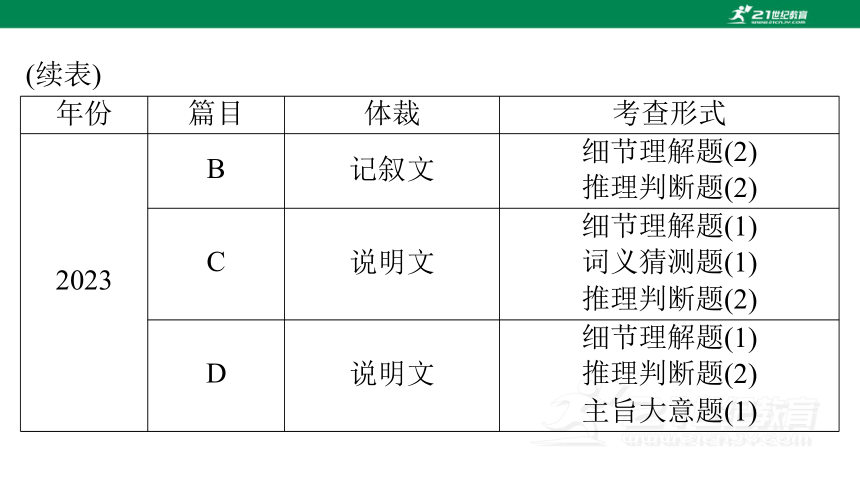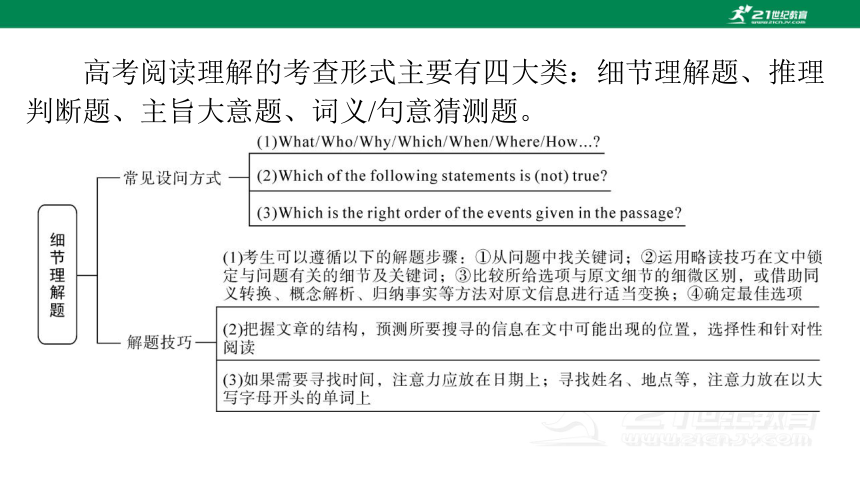2025年高考总复习英语 第三部分题型备战 专题二 阅读理解[配套课件]
文档属性
| 名称 | 2025年高考总复习英语 第三部分题型备战 专题二 阅读理解[配套课件] |  | |
| 格式 | ppt | ||
| 文件大小 | 1.8MB | ||
| 资源类型 | 试卷 | ||
| 版本资源 | 通用版 | ||
| 科目 | 英语 | ||
| 更新时间 | 2024-10-14 14:39:54 | ||
图片预览









文档简介
(共28张PPT)
专题二 阅读理解
2025年高考一轮总复习
第三部分 题型备战
一、题型要求
阅读部分第一节共 15 小题,每小题 2.5 分。要求考生根据所
提供的 4 篇短文内容,从每小题所给的 4 个选项中选出最佳选项。
年份 篇目 体裁 考查形式
2021 A 应用文 细节理解题(3)
B 记叙文 细节理解题(2)
推理判断题(2)
C 说明文 细节理解题(2)
词义猜测题(1)
主旨大意题(1)
二、命题分析
2021—2023 年新高考Ⅰ卷阅读理解 A—D 篇体裁与考查形式
年份 篇目 体裁 考查形式
2021 D 论述文 细节理解题(1)
推理判断题(2)
主旨大意题(1)
2022 A 应用文 细节理解题(1)
推理判断题(2)
B 说明文 推理判断题(1)
细节理解题(3)
(续表)
年份 篇目 体裁 考查形式
2022 C 说明文 细节理解题(1)
推理判断题(2)
词义猜测题(1)
D 说明文 细节理解题(2)
推理判断题(1)
主旨大意题(1)
2023 A 应用文 细节理解题(2)
推理判断题(1)
(续表)
年份 篇目 体裁 考查形式
2023 B 记叙文 细节理解题(2)
推理判断题(2)
C 说明文 细节理解题(1)
词义猜测题(1)
推理判断题(2)
D 说明文 细节理解题(1)
推理判断题(2)
主旨大意题(1)
(续表)
高考英语阅读理解文章的文体类型主要有:记叙文、说明文、
应用文和论述文。不同的文体有不同的段落组织方式和脉络层次,
也有着不同的解题技巧。
高考阅读理解的考查形式主要有四大类:细节理解题、推理
判断题、主旨大意题、词义/句意猜测题。
词类 例词
褒义词 support(支持),supportive(支持的),approve(赞成),approving(赞同的),for(支持),in favour of(支持),optimistic(乐观的),positive(积极的),helpful(有帮助的),admiring(赞赏的),interested(感兴趣的),praise(赞扬)
常见的表示态度的词
词类 例词
贬义词 critical(批评的),negative(否定的),suspicious(怀疑的),disappointed(失望的),biased(有偏见的),doubtful(怀疑的),pessimistic(悲观的),depressed(沮丧的),uninterested(冷漠的),skeptical(怀疑的),opposed(反对的),doubt(怀疑)
中性词 factual(事实的),objective(客观的),neutral(中立的)
(续表)
(2023·新高考Ⅰ卷·阅读理解 D)
阅读下列短文,从每题所给的 A、B、C、D 四个选项中选出
最佳选项。
On March 7, 1907, the English statistician Francis Galton published
a paper which illustrated what has come to be known as the “wisdom
of crowds” effect.The experiment of estimation he conducted showed
that in some cases, the average of a large number of independent
estimates could be quite accurate.
This effect capitalises on the fact that when people make errors,
those errors aren't always the same.Some people will tend to
overestimate, and some to underestimate.When enough of these errors
are averaged together, they cancel each other out, resulting in a more
accurate estimate.If people are similar and tend to make the same
errors, then their errors won't cancel each other out.In more technical
terms, the wisdom of crowds requires that people's estimates be
independent.If for whatever reasons, people's errors become correlated
or dependent, the accuracy of the estimate will go down.
But a new study led by Joaquin Navajas offered an interesting
twist (转折) on this classic phenomenon.The key finding of the study
was that when crowds were further divided into smaller groups that
were allowed to have a discussion, the averages from these groups
were more accurate than those from an equal number of independent
individuals.For instance, the average obtained from the estimates of
four discussion groups of five was significantly more accurate than the
average obtained from 20 independent individuals.
In a follow-up study with 100 university students, the researchers
tried to get a better sense of what the group members actually did in
their discussion.Did they tend to go with those most confident about
their estimates Did they follow those least willing to change their
minds This happened some of the time, but it wasn't the dominant
response.Most frequently, the groups reported that they “shared
arguments and reasoned together”.Somehow, these arguments and
reasoning resulted in a global reduction in error.Although the studies
led by Navajas have limitations and many questions remain, the
potential implications for group discussion and decision-making are
enormous.
本文是一篇说明文。没有人是一座孤岛,文章陈述了“群体
智慧”效应。实验表明,在某些情况下,大量独立估计的平均值
可能是相当准确的。
1.What is Paragraph 2 of the text mainly about
A.The methods of estimation.
B.The underlying logic of the effect.
C.The causes of people's errors.
D.The design of Galton's experiment.
B
主旨大意题。根据第二段的“This effect capitalises on the
fact that when people make errors, those errors aren't always the
same.Some people will tend to overestimate, and some to
underestimate.When enough of these errors are averaged together,
they cancel each other out, resulting in a more accurate estimate.If
people are similar and tend to make the same errors, then their errors
won't cancel each other out.In more technical terms, the wisdom of
crowds requires that people's estimates be independent.If for whatever
reasons, people's errors become correlated or dependent, the accuracy
of the estimate will go down.(这种效应利用了这样一个事实,即当
人们犯错误时,这些错误并不总是相同的。有些人常常会高估,
或者低估。当这些误差中有足够多的误差被平均在一起时,它们
会相互抵消,从而产生更准确的估计。如果相似的人倾向于犯同
样的错误,那么他们的错误不会相互抵消。从更专业的角度来说,
群众的智慧要求人们的估计是独立的。如果由于任何原因,人们
的错误变得相关或依赖,估计的准确性就会下降。)”可知,本段
阐述了人们所犯的错误不总是相同的,各不相同的误差平均在一
起,相互抵消就会产生更准确的估计,讨论了独立估计的平均如
何由于误差的消除而产生更准确的预测。因此本段主要解释了“群
体智慧”效应这一现象的基本逻辑。故选 B。
2.Navajas' study found that the average accuracy could increase
even if ________.
A.the crowds were relatively small
B.there were occasional underestimates
C.individuals did not communicate
D.estimates were not fully independent
D
细节理解题。根据第二段的“In more technical terms, the
wisdom of crowds requires that people's estimates be independent.(从
更专业的角度来说,群众的智慧要求人们的估计是独立的。)”和
第三段的“The key finding of the study was that when crowds were
further divided into smaller groups that were allowed to have a
discussion, the averages from these groups were more accurate than
those from an equal number of independent individuals.For instance,
the average obtained from the estimates of four discussion groups of
five was significantly more accurate than the average obtained from
20 independent individuals.(这项研究的关键发现,当人群被进一步
划分为允许进行讨论的小组时,这些小组的平均值比同等数量的
独立个体的平均值更准确。例如,从四个五人讨论组的估计中获
得的平均值明显比从 20 个独立个体获得的平均值更准确。)”可
知,人们在没有独立的情况下,分成更小的群体,平均值是更准
确的,说明即使在估计数字并非完全独立的情况下,也是可以做
到提高准确率的。故选 D。
3.What did the follow-up study focus on
A.The size of the groups.
B.The dominant members.
C.The discussion process.
D.The individual estimates.
C 推理判断题。根据第四段的“In a follow-up study with 100
university students, the researchers tried to get a better sense of what
the group members actually did in their discussion.Did they tend to go
with those most confident about their estimates Did they follow those
least willing to change their minds (在一项针对 100 名大学生的后
续研究中,研究人员试图更好地了解小组成员在讨论中的实际行
为。他们是否倾向于选择那些对自己的估计最有信心的人?他们
追随那些最不愿意改变主意的人吗?)”可知,在后续研究中,研
究人员试图更好地了解小组成员在讨论中实际做了什么。结合两
个问题,因此可知后续研究的重点是小组内的讨论过程。故选 C。
4.What is the author's attitude toward Navajas' studies
A.Unclear.
B.Dismissive.
C.Doubtful.
D.Approving.
D 推理判断题。根据最后一段的“Although the studies led by
Navajas have limitations and many questions remain, the potential
implications for group discussion and decision-making are enormous.
(尽管 Navajas 领导的研究有局限性,仍存在许多问题,但对小组
讨论和决策的潜在影响是巨大的)”可知,作者认为虽然 Navajas
领导的研究有局限性,也存在许多问题,但对小组讨论和决策的
潜在影响巨大。因此推断作者对于 Navajas 的研究表示一定的赞许
和支持。故选 D。
谢谢
21世纪教育网(www.21cnjy.com)
中小学教育资源网站
兼职招聘:
https://www.21cnjy.com/recruitment/home/admin
专题二 阅读理解
2025年高考一轮总复习
第三部分 题型备战
一、题型要求
阅读部分第一节共 15 小题,每小题 2.5 分。要求考生根据所
提供的 4 篇短文内容,从每小题所给的 4 个选项中选出最佳选项。
年份 篇目 体裁 考查形式
2021 A 应用文 细节理解题(3)
B 记叙文 细节理解题(2)
推理判断题(2)
C 说明文 细节理解题(2)
词义猜测题(1)
主旨大意题(1)
二、命题分析
2021—2023 年新高考Ⅰ卷阅读理解 A—D 篇体裁与考查形式
年份 篇目 体裁 考查形式
2021 D 论述文 细节理解题(1)
推理判断题(2)
主旨大意题(1)
2022 A 应用文 细节理解题(1)
推理判断题(2)
B 说明文 推理判断题(1)
细节理解题(3)
(续表)
年份 篇目 体裁 考查形式
2022 C 说明文 细节理解题(1)
推理判断题(2)
词义猜测题(1)
D 说明文 细节理解题(2)
推理判断题(1)
主旨大意题(1)
2023 A 应用文 细节理解题(2)
推理判断题(1)
(续表)
年份 篇目 体裁 考查形式
2023 B 记叙文 细节理解题(2)
推理判断题(2)
C 说明文 细节理解题(1)
词义猜测题(1)
推理判断题(2)
D 说明文 细节理解题(1)
推理判断题(2)
主旨大意题(1)
(续表)
高考英语阅读理解文章的文体类型主要有:记叙文、说明文、
应用文和论述文。不同的文体有不同的段落组织方式和脉络层次,
也有着不同的解题技巧。
高考阅读理解的考查形式主要有四大类:细节理解题、推理
判断题、主旨大意题、词义/句意猜测题。
词类 例词
褒义词 support(支持),supportive(支持的),approve(赞成),approving(赞同的),for(支持),in favour of(支持),optimistic(乐观的),positive(积极的),helpful(有帮助的),admiring(赞赏的),interested(感兴趣的),praise(赞扬)
常见的表示态度的词
词类 例词
贬义词 critical(批评的),negative(否定的),suspicious(怀疑的),disappointed(失望的),biased(有偏见的),doubtful(怀疑的),pessimistic(悲观的),depressed(沮丧的),uninterested(冷漠的),skeptical(怀疑的),opposed(反对的),doubt(怀疑)
中性词 factual(事实的),objective(客观的),neutral(中立的)
(续表)
(2023·新高考Ⅰ卷·阅读理解 D)
阅读下列短文,从每题所给的 A、B、C、D 四个选项中选出
最佳选项。
On March 7, 1907, the English statistician Francis Galton published
a paper which illustrated what has come to be known as the “wisdom
of crowds” effect.The experiment of estimation he conducted showed
that in some cases, the average of a large number of independent
estimates could be quite accurate.
This effect capitalises on the fact that when people make errors,
those errors aren't always the same.Some people will tend to
overestimate, and some to underestimate.When enough of these errors
are averaged together, they cancel each other out, resulting in a more
accurate estimate.If people are similar and tend to make the same
errors, then their errors won't cancel each other out.In more technical
terms, the wisdom of crowds requires that people's estimates be
independent.If for whatever reasons, people's errors become correlated
or dependent, the accuracy of the estimate will go down.
But a new study led by Joaquin Navajas offered an interesting
twist (转折) on this classic phenomenon.The key finding of the study
was that when crowds were further divided into smaller groups that
were allowed to have a discussion, the averages from these groups
were more accurate than those from an equal number of independent
individuals.For instance, the average obtained from the estimates of
four discussion groups of five was significantly more accurate than the
average obtained from 20 independent individuals.
In a follow-up study with 100 university students, the researchers
tried to get a better sense of what the group members actually did in
their discussion.Did they tend to go with those most confident about
their estimates Did they follow those least willing to change their
minds This happened some of the time, but it wasn't the dominant
response.Most frequently, the groups reported that they “shared
arguments and reasoned together”.Somehow, these arguments and
reasoning resulted in a global reduction in error.Although the studies
led by Navajas have limitations and many questions remain, the
potential implications for group discussion and decision-making are
enormous.
本文是一篇说明文。没有人是一座孤岛,文章陈述了“群体
智慧”效应。实验表明,在某些情况下,大量独立估计的平均值
可能是相当准确的。
1.What is Paragraph 2 of the text mainly about
A.The methods of estimation.
B.The underlying logic of the effect.
C.The causes of people's errors.
D.The design of Galton's experiment.
B
主旨大意题。根据第二段的“This effect capitalises on the
fact that when people make errors, those errors aren't always the
same.Some people will tend to overestimate, and some to
underestimate.When enough of these errors are averaged together,
they cancel each other out, resulting in a more accurate estimate.If
people are similar and tend to make the same errors, then their errors
won't cancel each other out.In more technical terms, the wisdom of
crowds requires that people's estimates be independent.If for whatever
reasons, people's errors become correlated or dependent, the accuracy
of the estimate will go down.(这种效应利用了这样一个事实,即当
人们犯错误时,这些错误并不总是相同的。有些人常常会高估,
或者低估。当这些误差中有足够多的误差被平均在一起时,它们
会相互抵消,从而产生更准确的估计。如果相似的人倾向于犯同
样的错误,那么他们的错误不会相互抵消。从更专业的角度来说,
群众的智慧要求人们的估计是独立的。如果由于任何原因,人们
的错误变得相关或依赖,估计的准确性就会下降。)”可知,本段
阐述了人们所犯的错误不总是相同的,各不相同的误差平均在一
起,相互抵消就会产生更准确的估计,讨论了独立估计的平均如
何由于误差的消除而产生更准确的预测。因此本段主要解释了“群
体智慧”效应这一现象的基本逻辑。故选 B。
2.Navajas' study found that the average accuracy could increase
even if ________.
A.the crowds were relatively small
B.there were occasional underestimates
C.individuals did not communicate
D.estimates were not fully independent
D
细节理解题。根据第二段的“In more technical terms, the
wisdom of crowds requires that people's estimates be independent.(从
更专业的角度来说,群众的智慧要求人们的估计是独立的。)”和
第三段的“The key finding of the study was that when crowds were
further divided into smaller groups that were allowed to have a
discussion, the averages from these groups were more accurate than
those from an equal number of independent individuals.For instance,
the average obtained from the estimates of four discussion groups of
five was significantly more accurate than the average obtained from
20 independent individuals.(这项研究的关键发现,当人群被进一步
划分为允许进行讨论的小组时,这些小组的平均值比同等数量的
独立个体的平均值更准确。例如,从四个五人讨论组的估计中获
得的平均值明显比从 20 个独立个体获得的平均值更准确。)”可
知,人们在没有独立的情况下,分成更小的群体,平均值是更准
确的,说明即使在估计数字并非完全独立的情况下,也是可以做
到提高准确率的。故选 D。
3.What did the follow-up study focus on
A.The size of the groups.
B.The dominant members.
C.The discussion process.
D.The individual estimates.
C 推理判断题。根据第四段的“In a follow-up study with 100
university students, the researchers tried to get a better sense of what
the group members actually did in their discussion.Did they tend to go
with those most confident about their estimates Did they follow those
least willing to change their minds (在一项针对 100 名大学生的后
续研究中,研究人员试图更好地了解小组成员在讨论中的实际行
为。他们是否倾向于选择那些对自己的估计最有信心的人?他们
追随那些最不愿意改变主意的人吗?)”可知,在后续研究中,研
究人员试图更好地了解小组成员在讨论中实际做了什么。结合两
个问题,因此可知后续研究的重点是小组内的讨论过程。故选 C。
4.What is the author's attitude toward Navajas' studies
A.Unclear.
B.Dismissive.
C.Doubtful.
D.Approving.
D 推理判断题。根据最后一段的“Although the studies led by
Navajas have limitations and many questions remain, the potential
implications for group discussion and decision-making are enormous.
(尽管 Navajas 领导的研究有局限性,仍存在许多问题,但对小组
讨论和决策的潜在影响是巨大的)”可知,作者认为虽然 Navajas
领导的研究有局限性,也存在许多问题,但对小组讨论和决策的
潜在影响巨大。因此推断作者对于 Navajas 的研究表示一定的赞许
和支持。故选 D。
谢谢
21世纪教育网(www.21cnjy.com)
中小学教育资源网站
兼职招聘:
https://www.21cnjy.com/recruitment/home/admin
